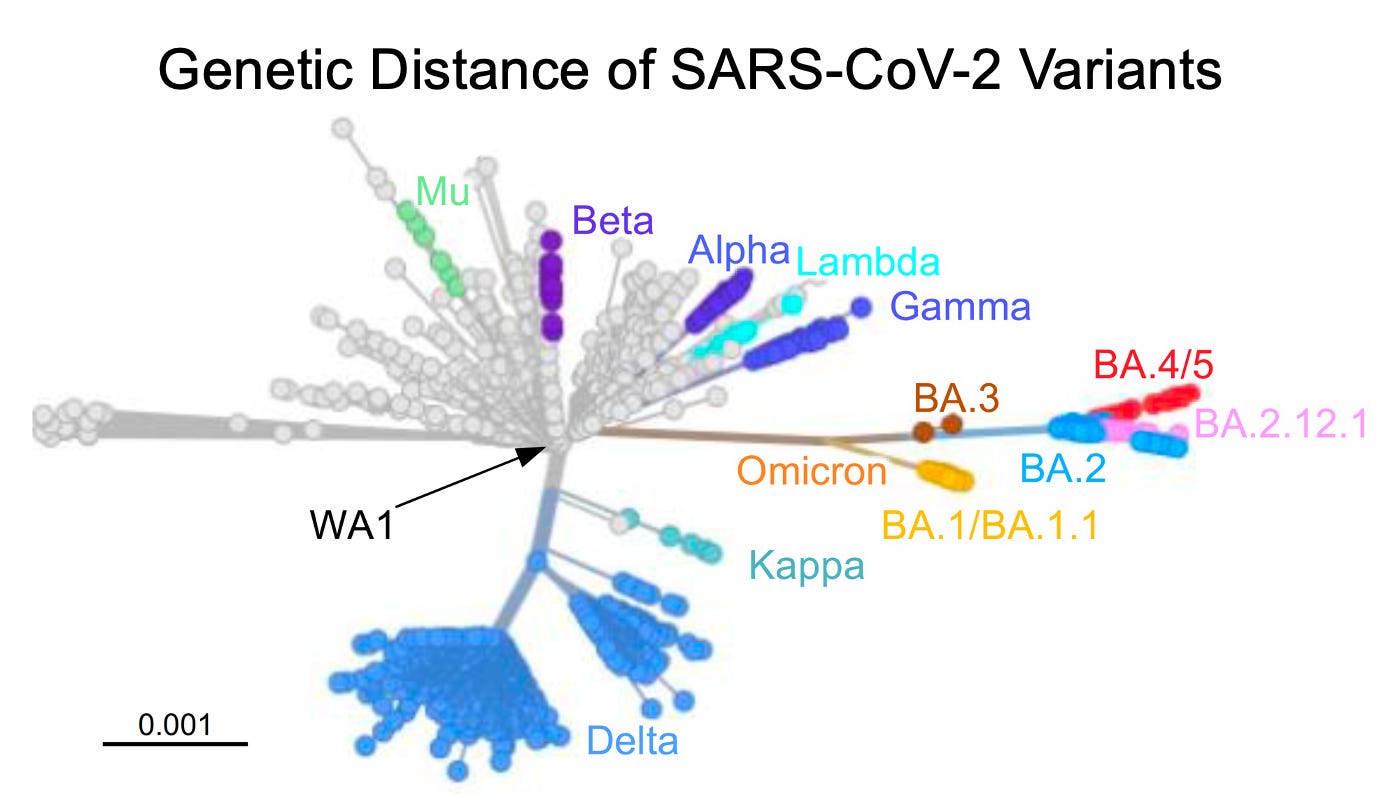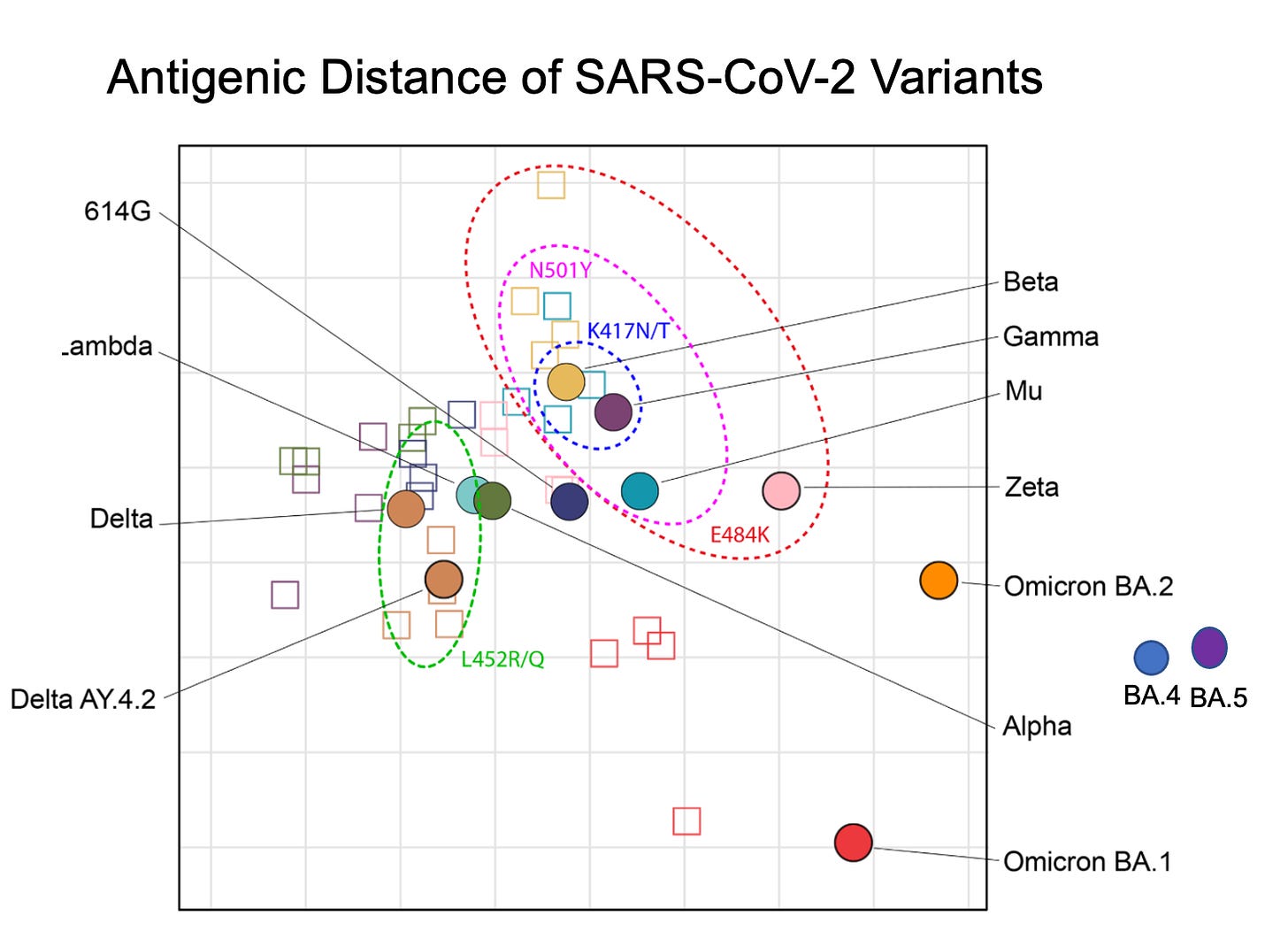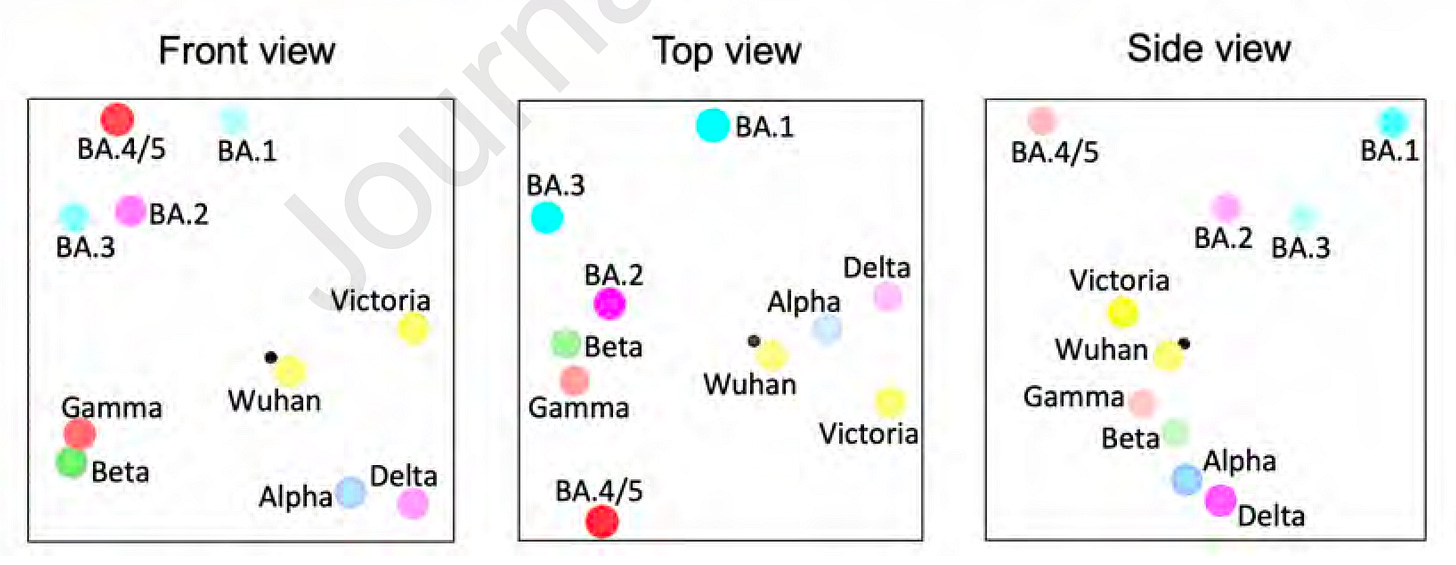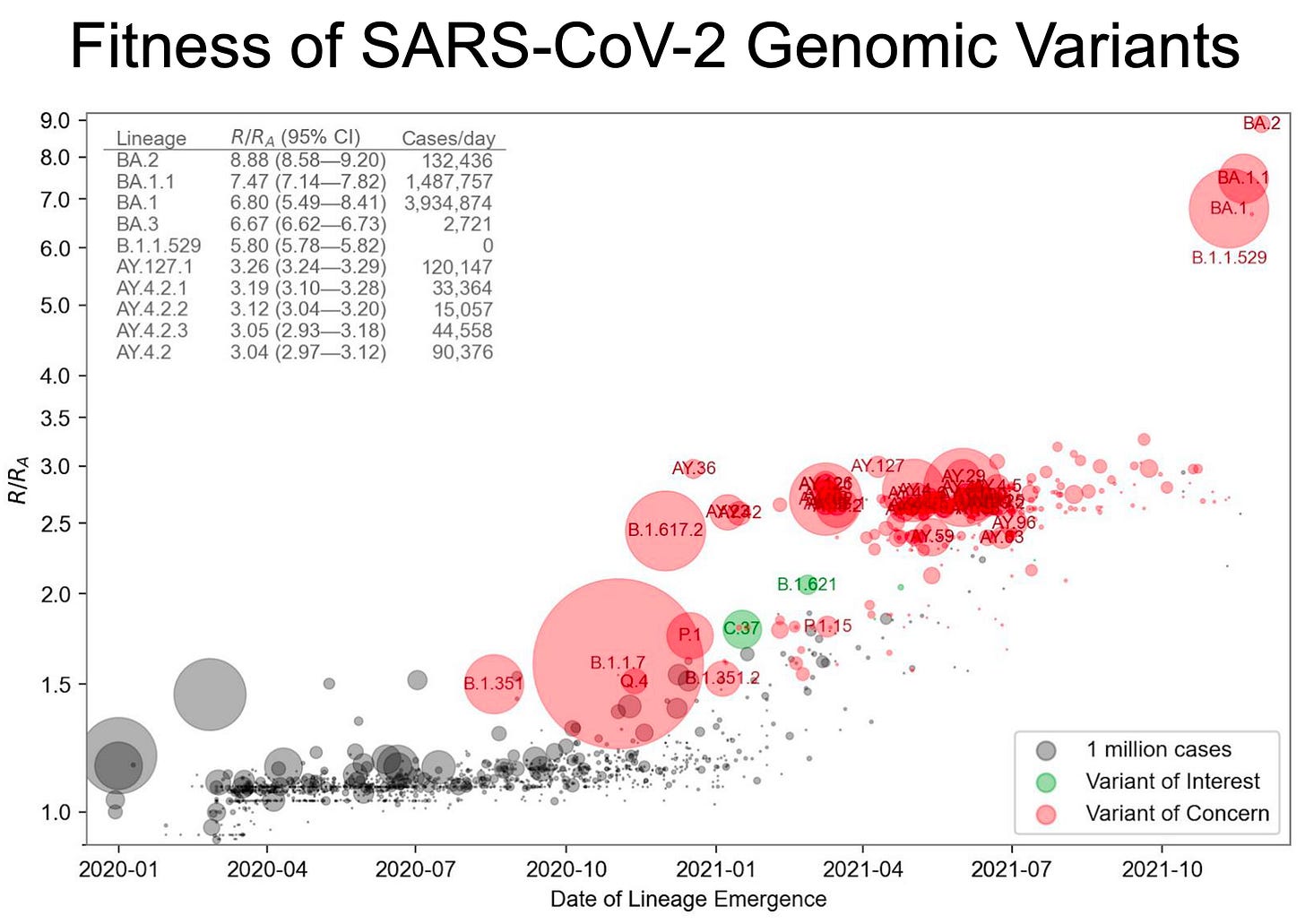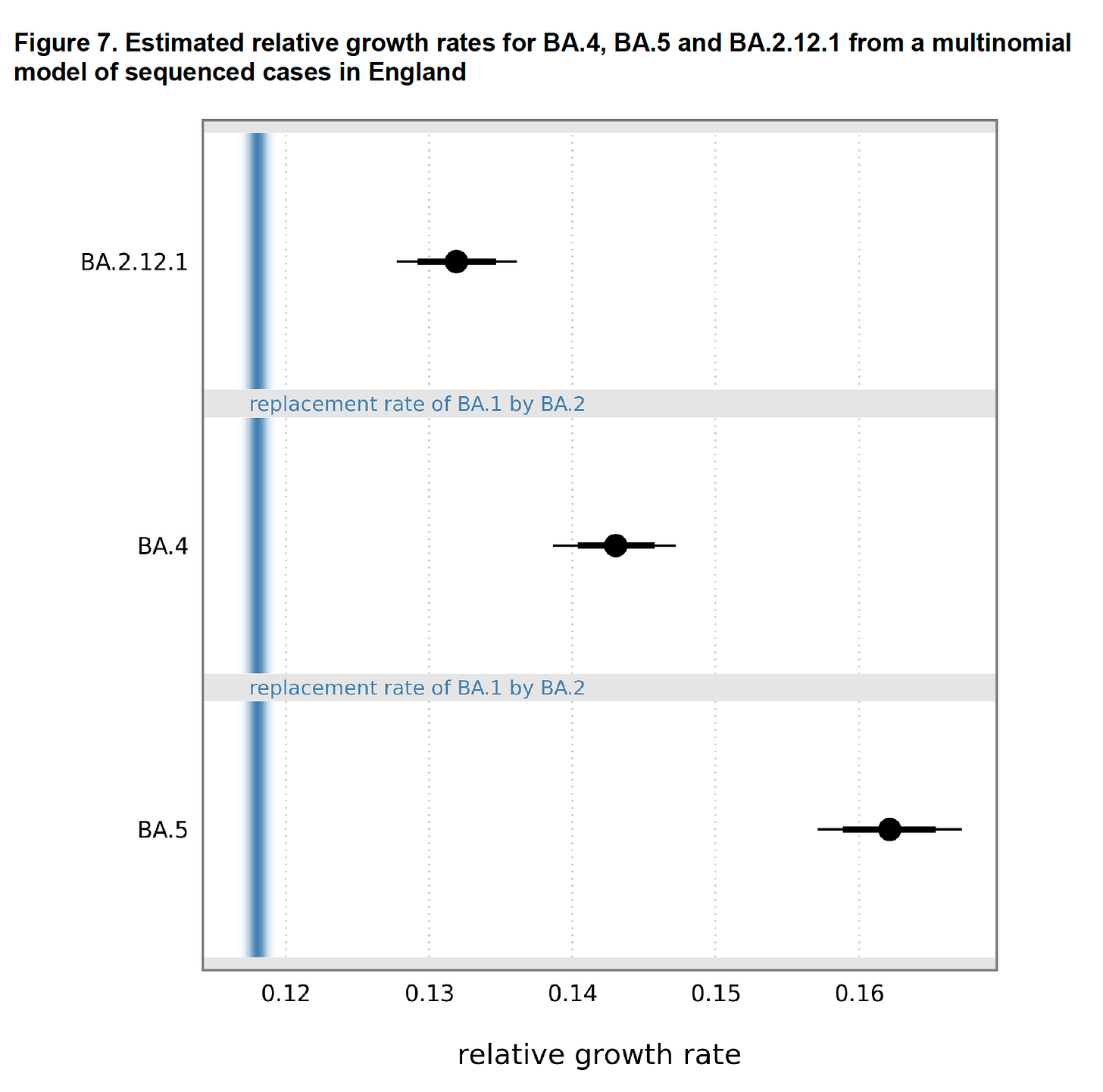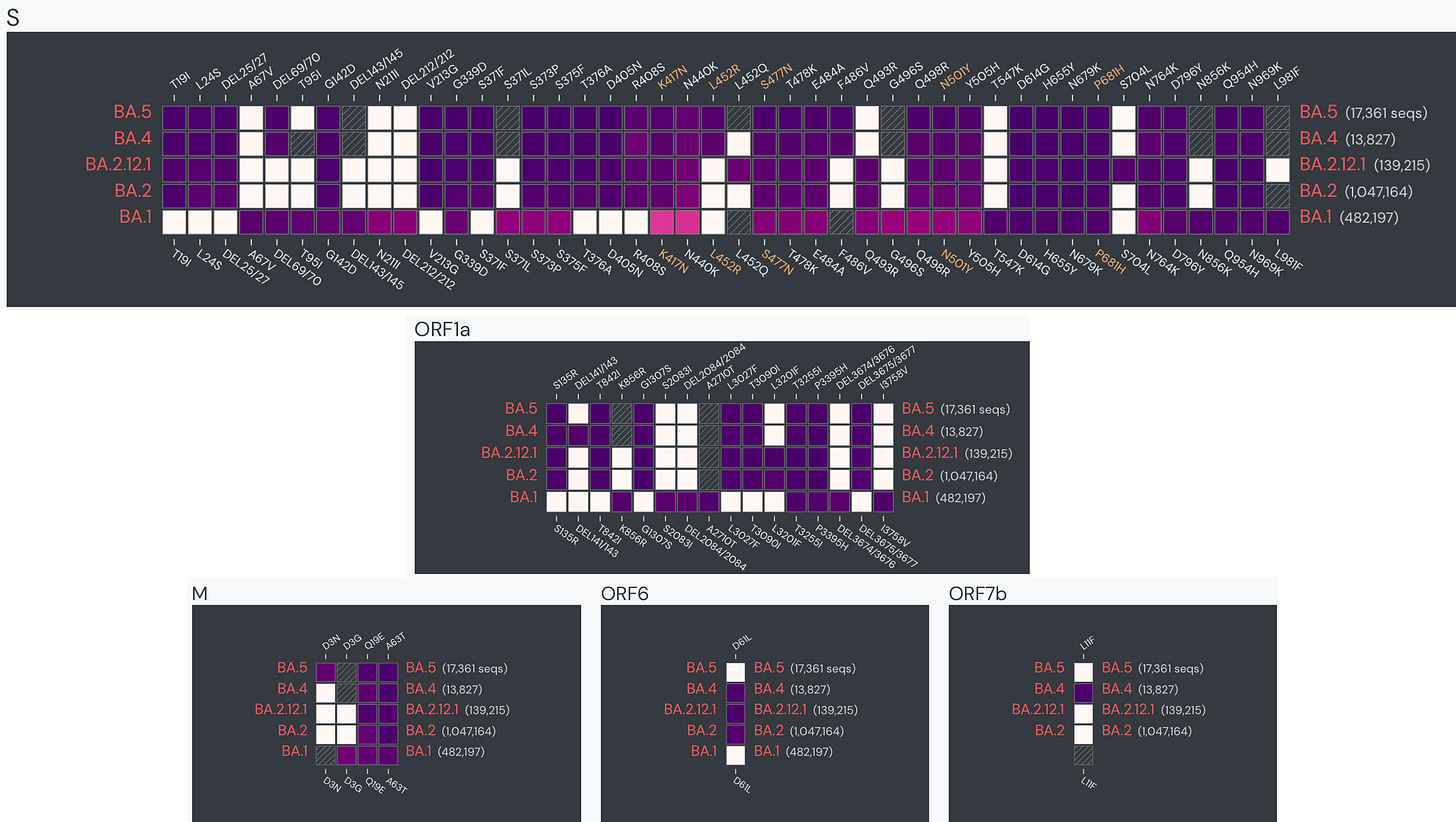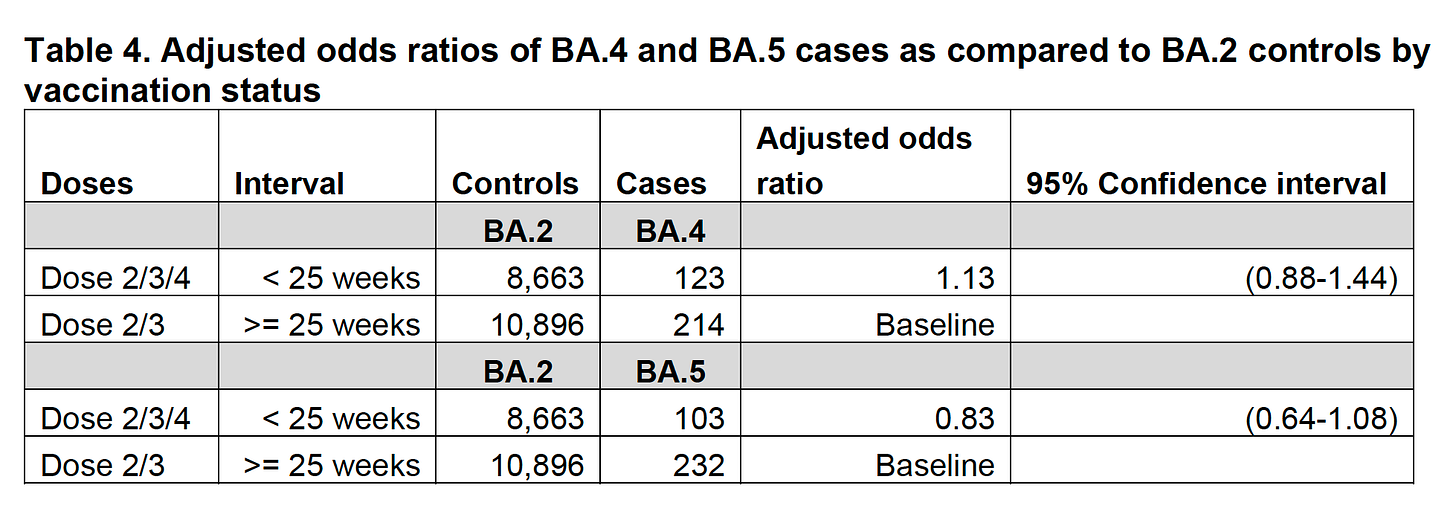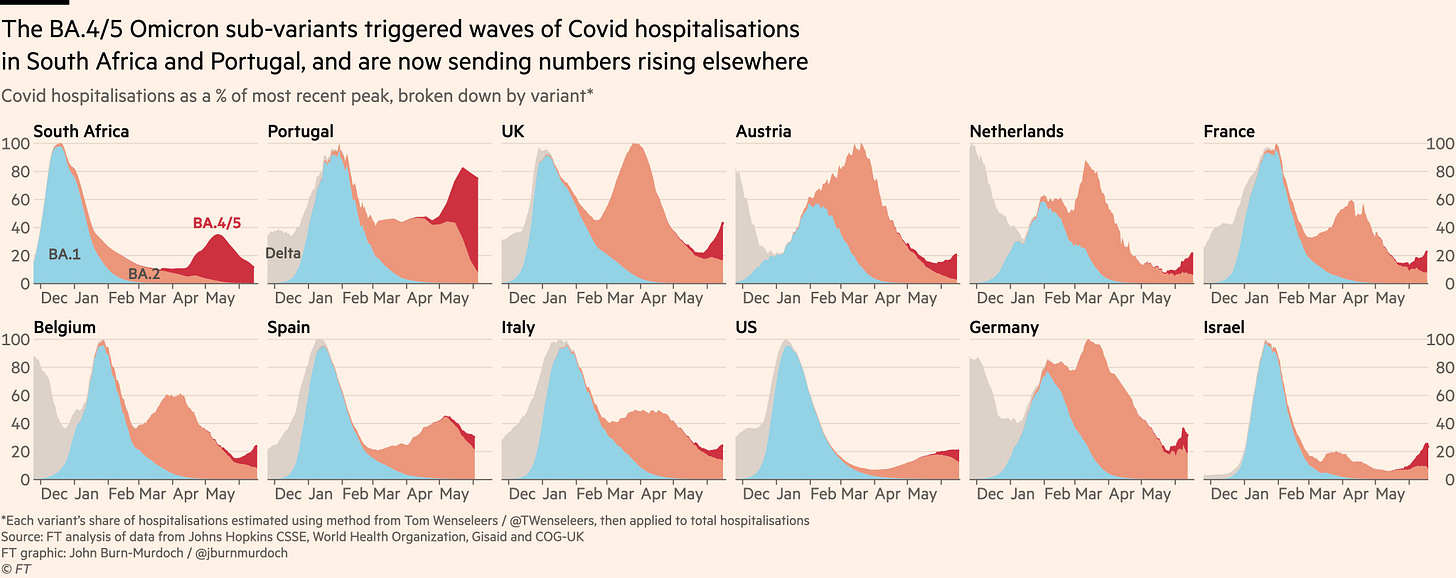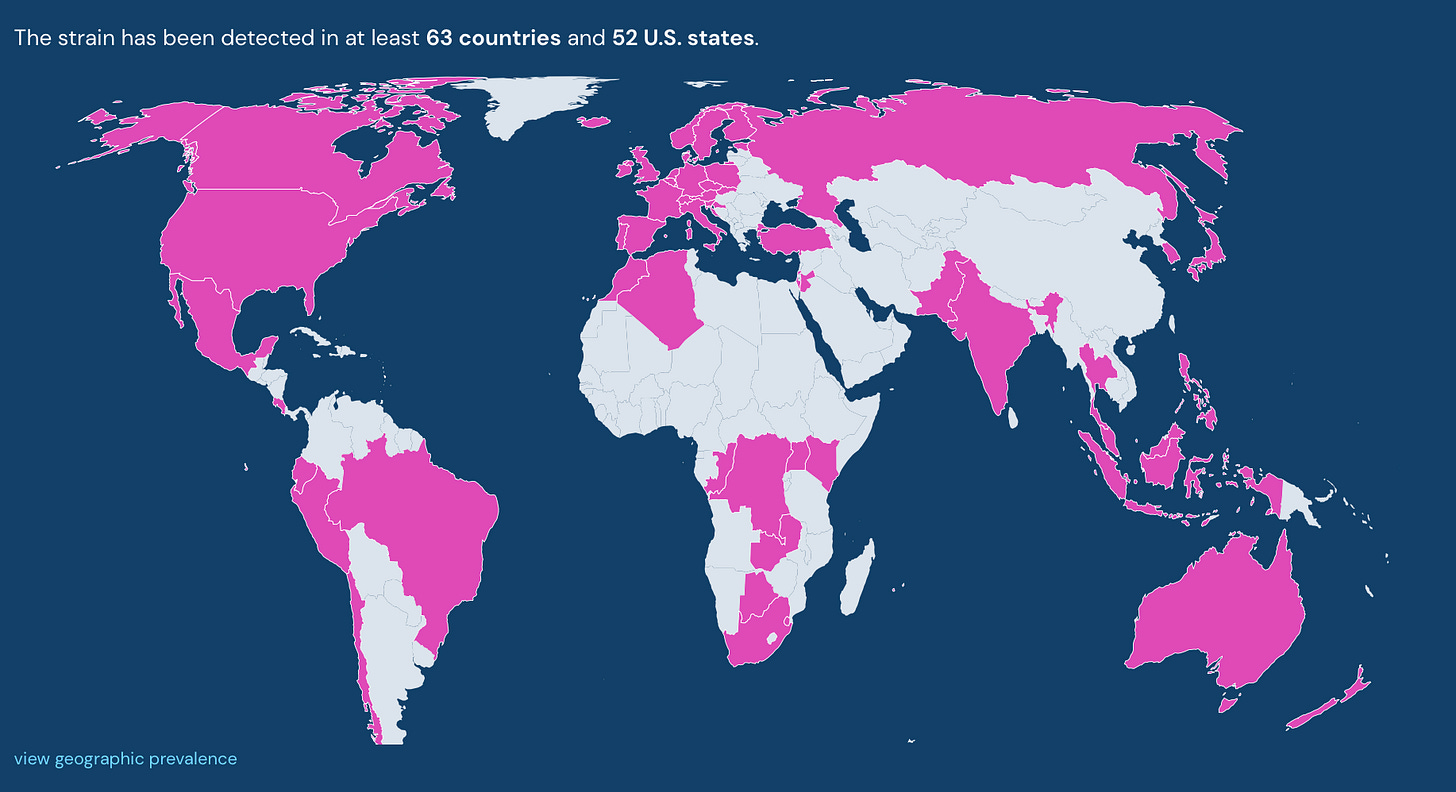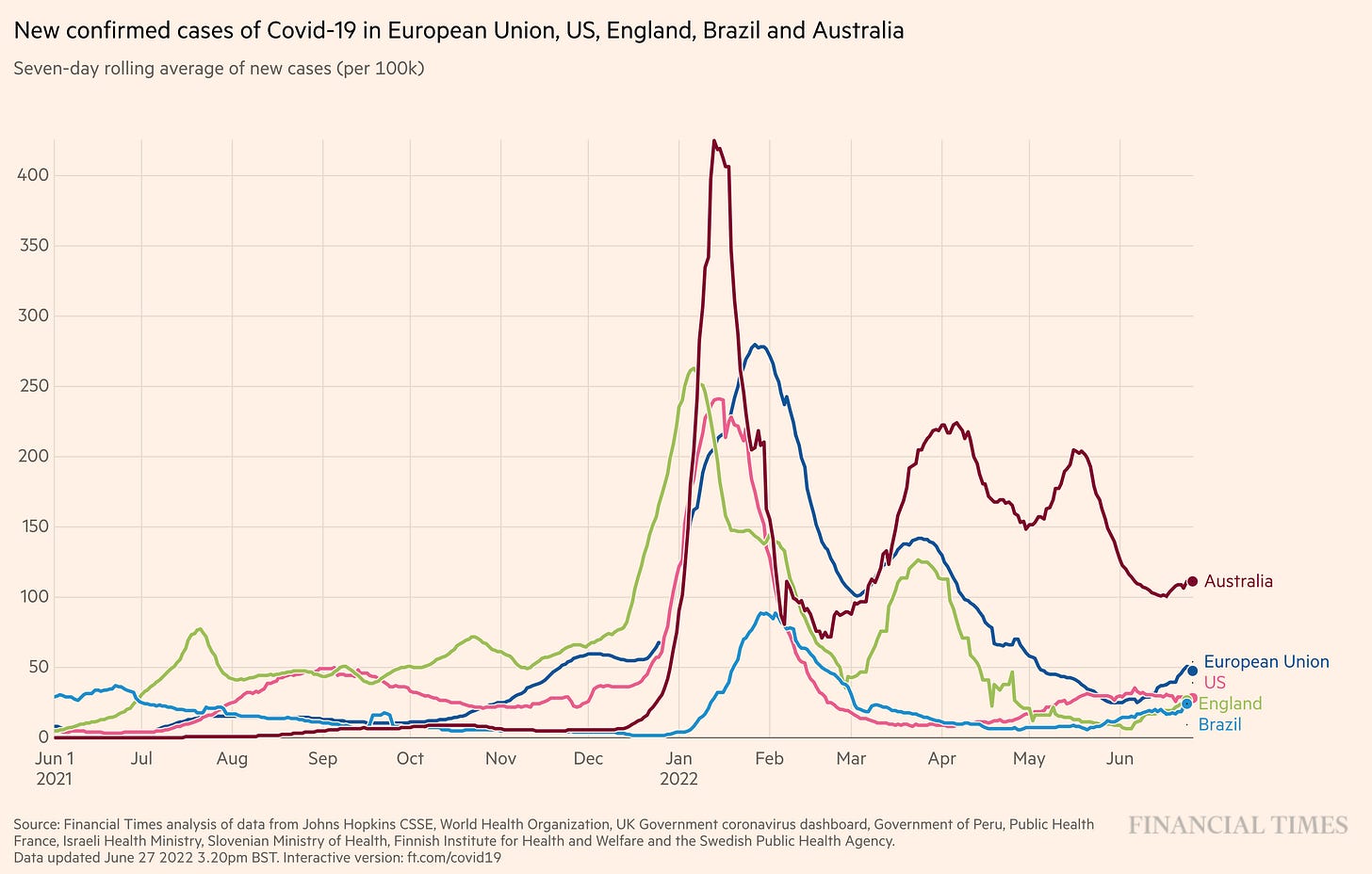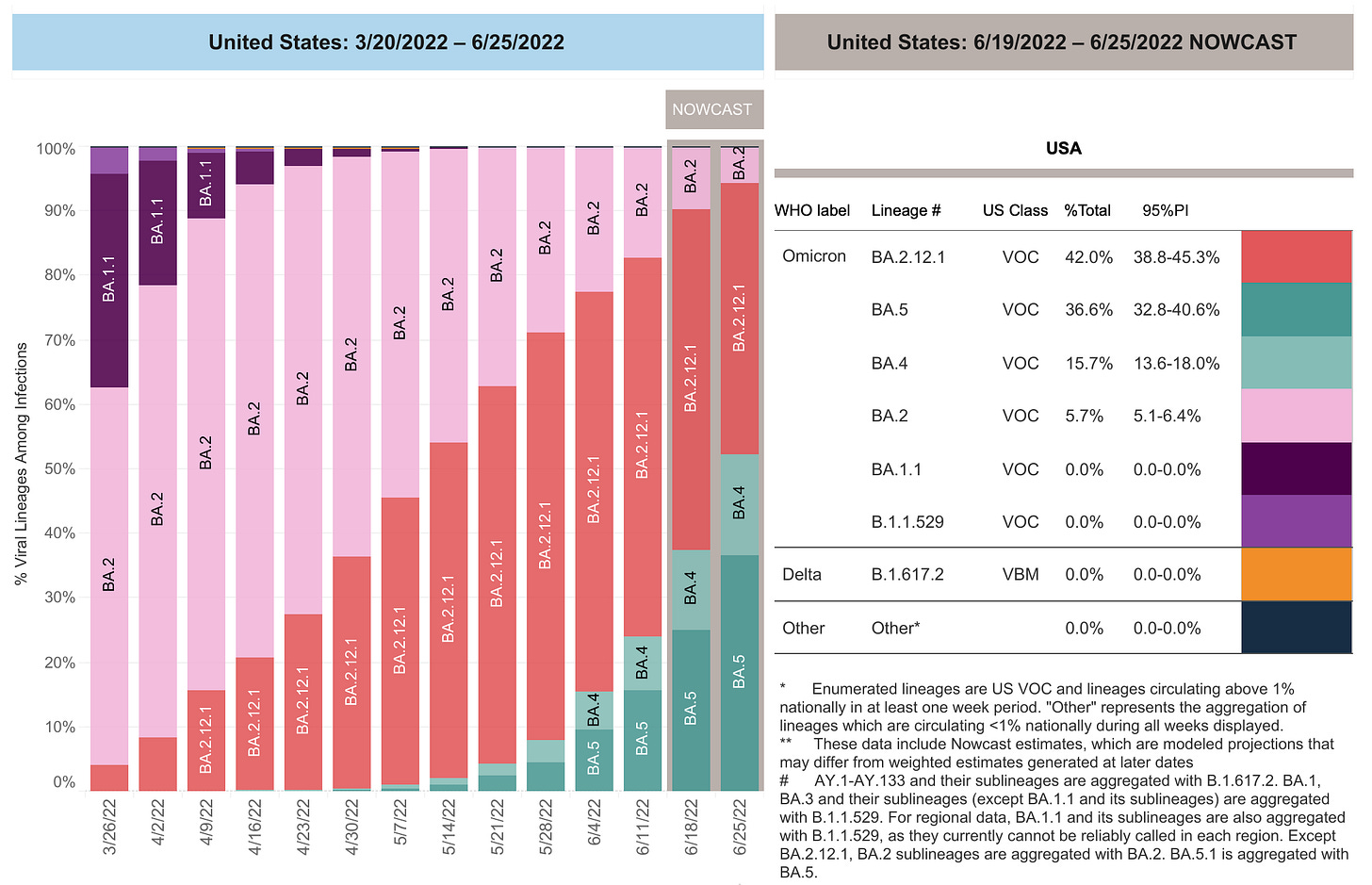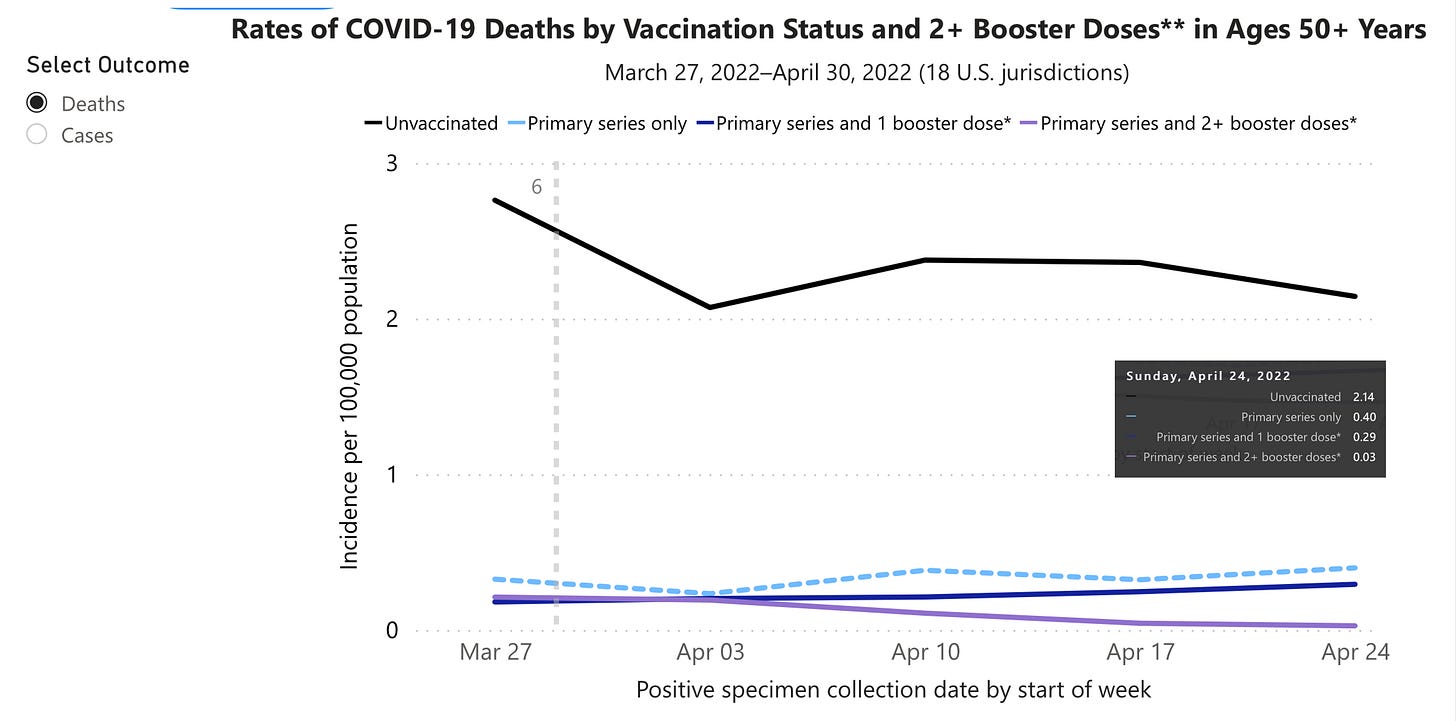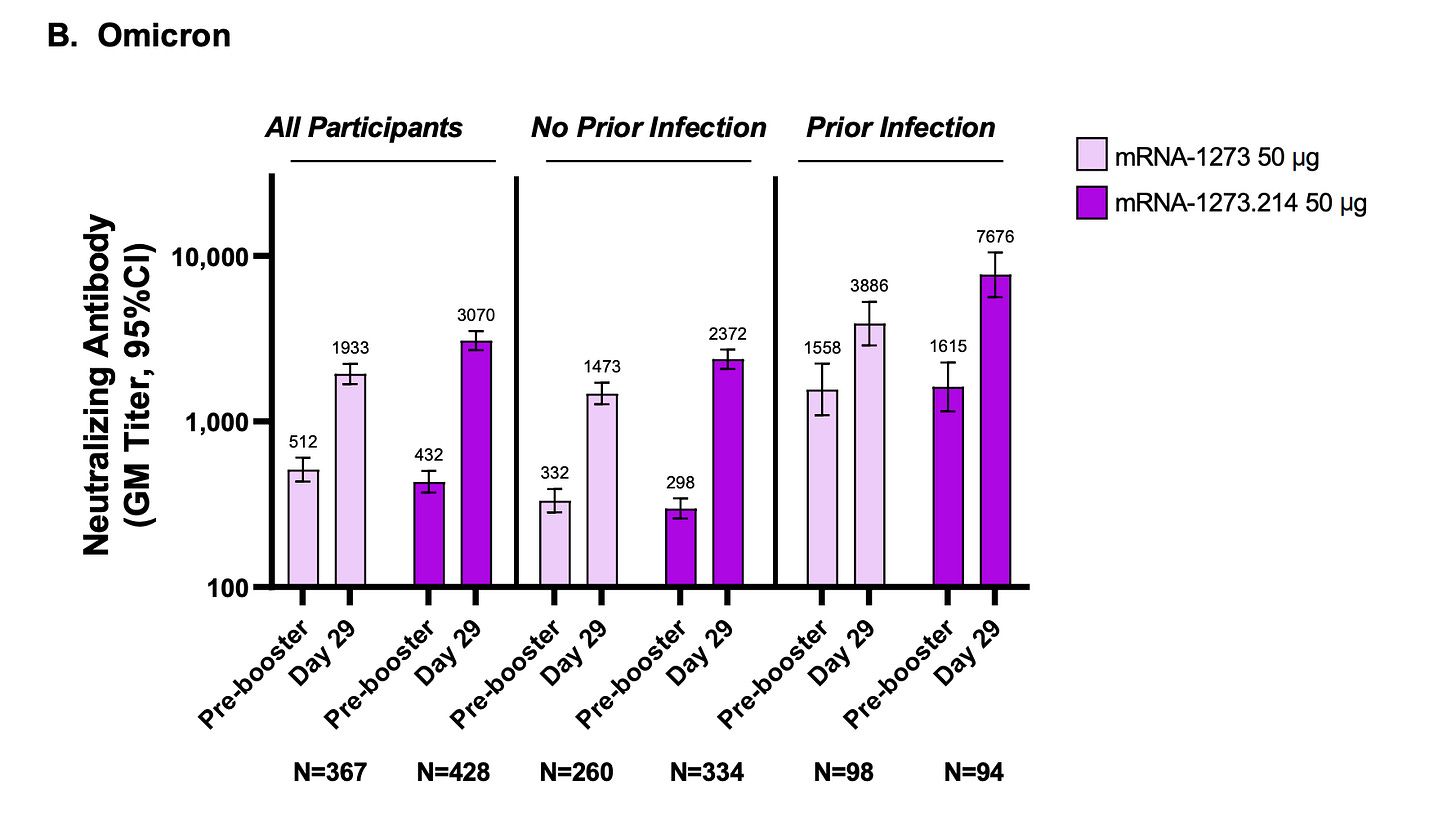The Omicron sub-variant BA.5 is the worst version of the virus that we’ve seen. It takes immune escape, already extensive, to the next level, and, as a function of that, enhanced transmissibility, well beyond Omicron (BA.1) and other Omicron family variants that we’ve seen (including BA.1.1, BA.2, BA.2.12.1, and BA.4). You could say it’s not so bad because there hasn’t been a marked rise in hospitalizations and deaths as we saw with Omicron, but that’s only because we had such a striking adverse impact from Omicron, for which there is at least some cross-immunity (BA.1 to BA.5). Here I will review (1) what we know about its biology; (2) its current status around the world; and (3) the ways we can defend against it.
The biology of BA.5
There are many ways to get a sense of how distinct BA.5 is compared with prior strains and the Omicron family. There’s its genetic distance—how its sequence morphed over time, indicative that BA.4 and BA.5 are derivatives of BA.2, in different limbs from BA.1
Then there’s the antigenic map, that tells us about the virus’s spike protein and how our immune system “sees” it. BA.4, which has a very similar spike protein sequence to BA.5 (vida infra), have not been mapped by this report, but theoretically they’d be off the chart as I’ve shown here. You can see that the antigenic distance from BA.1 to BA.2 is far greater than the ancestral strain to Delta or Beta or Gamma. This is the basis for the immune escape of BA.5—our relatively poor recognition of and response to the spike protein.
These investigators did antigenically map BA.4/5 and here are multiple views to show how far away they are from prior variants.
An important feature of the variant is its fitness, which is the composite of lineage growth, basic reproduction number, extent of immune-evasion and generation time. From an analysis of 6.4 million SARS-CoV-2 sequences, here is the fitness plot, and note that BA.2 is at the upper right, whereas BA.5 would be well off the chart for maximal fitness.
On the topic of fitness, it is noteworthy to look a the growth advantage of BA.5 relative to BA.4 and BA.2.12.1, as recently analyzed by the UKHSA
To recap, BA.5 is quite distinct and very fit, representing marked difference from all prior variants, but how was this achieved? There are major differences in the spike sequence, but BA.5 mutations extend beyond that to other parts of the virus as shown below, in comparison with the main Omicron variants, including how it differs from BA.4, mainly outside of the spike (S) protein.
Since we’re basically spike-centric, which discounts the potential of non-spike mutations (which are likely important for understanding BA.4 vs BA.5), here are the key sequence differences compared with BA.2 and the other Omicron variants
With that background, we turn to the immune response and consistently note from patient sera that BA.4 and BA.5 are the most immune-evasive variants with low levels of neutralizing antibody responses seen in multiple studies to date
The question of course comes up as to whether BA.5 is more virulent or pathogenic, capable of inducing worse disease. We only have one experimental study on that so far and it was shown that BA.4 and BA.5 induced worse disease in the Syrian hamster model and more efficiently spread in lung cell cultures.
Do the current vaccines work against BA.5? The new UKHSA report started to address this question, looking at symptomatic infections and severe disease, but it’s unclear. With the extent of BA.5’s immune evasion and the recent trends of lowered vaccine effectiveness vs severe disease (from 95% vs Delta with a booster to ~80% vs Omicron BA.1 or BA.2 with a booster) it would not be at all surprising to me to see further decline of protection against hospitalizations and deaths.
Current status around the world
While initially seen in South Africa soon thereafter in Portugal, BA.5 has been detected throughout the world. It led to a marked rise in hospitalizations in Portugal where it rapidly became dominant, and is now having such an effect, to a variable extent, in many European countries and Israel. It is frequently masked since the rise of BA.5 is occurring at the same time as the decline in BA.2 in several countries, and the magnitude of the BA.2 wave was different between countries.
But it’s not just these countries that are seeing the rise of BA.4 and BA.5—it’s around the world and it has happened very quickly.
And the toll it is taking on case rise is seen in both hemispheres.
It will very soon be the dominant (>50%) variant in the United States. BA.5 was ~37% as of June 25th. The risk of reinfection with BA.5 has substantially increased because prior infections are far away (antigenically) from an aligned immune response.
The ways we can defend against it
Obviously, the non-pharmacologic mitigating measures that include high-quality make (N95/KN95), physical distancing, ventilation and air filtration would help, but pandemic fatigue has led to very low level of adoption. Boosters would help, and it is noteworthy that for people age 50+ there is a substantial (14-fold) reduction for mortality as recently documented by the CDC for a 4th shot (previously published by the Israel investigators in multiple observational studies). That is 99% reduction in mortality for 4-shots vs 86% for 3 shots. But only 1 in 4 Americans age 50+ have had a fourth shot!
The big question now is whether an Omicron booster, directed to BA.1, will help when that variant is no longer with us, and we will be close to 100% BA.5 within a matter of weeks. And no doubt there will be further troublesome variants that lie ahead, be they more in the Omicron family or in a whole new lineage.
This topic is the thrust of an FDA Advisory Committee meeting this week. Both Moderna and Pfizer/BioNTech have submitted data to the FDA for a bivalent (ancestral + Omicron BA.1) or monovalent (BA.1 only, Pfizer) booster. Moderna also published a preprint on their Omicron booster (data below). While the neutralizing antibody levels were higher for these boosters vs BA.1 (vs the original vaccine), both vaccine programs showed they were 1/3 as high vs BA.4/5.
The issues that are being confronted at the FDA Advisory Committee center around whether an emergency authorization for a BA.1 booster is worthwhile now that the virus has moved onto a substantially different variant. The sad truth is that we can’t even get 75% of high-risk people to get a 4th shot (original vaccine) with a proven survival advantage. (Side note: million of these shots will soon expire, a profound waste, which should be made available to all people, age <50, who seek added protection). While BA.1 is much closer to BA.5 that the ancestral Wuhan strain, it still has substantial dissimilarities. Given the hyper-mutated Omicron as compared with Wuhan, a booster that has much of its 37 spike protein mutations incorporated would likely help to some degree for broadening immunity and providing some degree of enhanced protection vs symptomatic infections and severe disease. The unknown is to what extent? We have no clinical data, only immunologic and safety profile results.
Should we wait for a BA.5 booster? That will take months, and it should be noted it took more than 7 months for the Omicron BA.1 booster to be tested, a delay that is exceedingly long and unacceptable relative to the timing of validation and production of the original vaccines in 10 months during 2020.
There is no right answer but variant chasing is a flawed approach. By the time a BA.5 vaccine booster is potentially available, who knows what will be the predominant strain? All of this gets back to the vital need for new generation of vaccines that are universal, that is variant-proof—either against all sarbecoviruses or against all β-coronaviruses. And the pivotal importance of nasal vaccines to promote mucosal immunity and help block the transmission chain. These goals are paramount, along with more and better antiviral drugs, but they are not getting adequate traction or priority.
My recent posts about our Covid capitulation and the risk of reinfection have tried to hammer home the imperative of next-generation vaccines (pan-coronaviruses, as described above, and nasal) but the frustration keeps mounting as we now confront unsatisfactory deliberations on variant chasing. Meanwhile, new versions of the virus (think: the time it took from Omicron BA.1 to get to BA.5) are accelerating and we’re not done yet, by any stretch. It’s frankly sickening to watch this virus continue to outrun us, knowing we are so damn capable of getting ahead of it.
.

